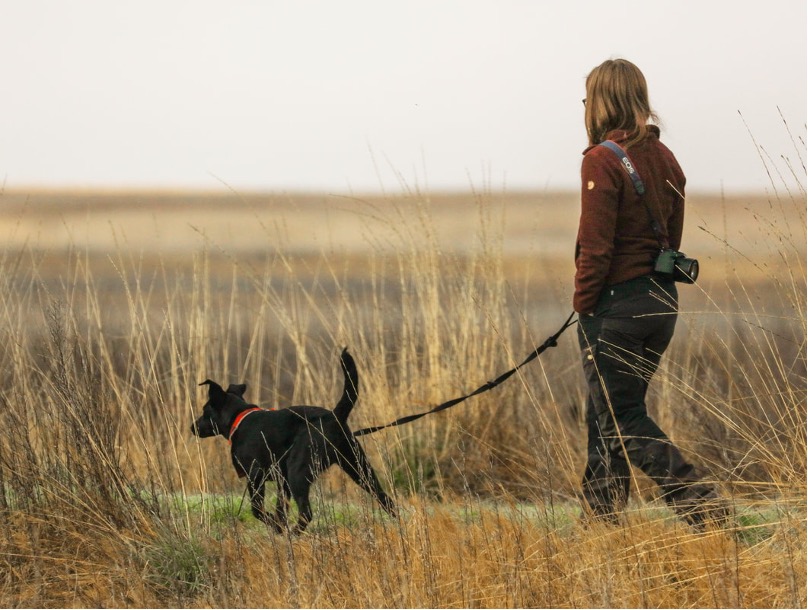
By Chris Zink DVM PhD DACVSMR
Pretty well everyone agrees that taking your dog for a walk is just about the best exercise your dog can get, right? Maybe… or maybe not.
What is Exercise Anyway?
When we talk about exercise, we are typically talking about a physical activity that improves or maintains our dog’s fitness. The components of fitness are strength, proprioception, balance, flexibility, proprioception, and aerobic capacity. So let’s analyze whether walks make our dogs fitter.
Do Walks Build Strength?
The focus of strength exercise is to build muscle size and tone. Strong muscles will allow your dog to do whatever kind of physical exercise he enjoys.
Maybe that includes friendly wrestling or playing chase with polite dog friends, swimming in a pool or pond, or running through a forest while on a hike. A dog that is strong will also be less likely to experience an injury when something unexpected happens and will be less likely to develop arthritis as their strength will help reduce the effects of chronic impact on the body.
The science of strength training for humans is pretty clear (1). To build strength, it is important to engage in exercises that will:
Taking your dog for a walk provides him or her with none of the above three characteristics. It doesn’t target the weakest parts of your dog’s body, it is certainly not low impact, and it is exceedingly difficult to recognize when your dog has reached overload, though it is certainly pretty clear when they have reached exhaustion, because they slow down and don’t want to participate any more.
Do Walks Develop Your Dog’s Proprioception?
Proprioception is all about body awareness – understanding where all of the parts of the body are in space. Proprioception is so important that there are specific neurological pathways that send neurological impulses from proprioceptive receptors in the skin and soft tissues, up the spinal cord to the brain to help direct the body’s movements. To improve proprioception, it is best to provide the body with a wide variety of different types of movements and surfaces to walk on.
If you are taking your dog for a walk at a constant pace over a consistent surface, it will not provide much proprioceptive input. So we’ll cross off that potential benefit of walking.
Do Walks Improve Your Dog’s Balance?
Much like proprioception, balance training strengthens your dog’s neurological system so that your dog can helps your dog negotiate complex movements and react safely when put in an unexpected situation.
Going for a walk over a relatively consistent surface like a sidewalk or mowed lawns doesn’t provide much challenge to your dog’s balance system.
Do Walks Make Your Dog More Flexible?
Flexibility is all about allowing the muscles to elongate and contract over their full working lengths. Flexibility exercises are usually performed with the dog in a stationary position, allowing the dog to fully flex and extend the muscles without overstretching and risking damage.
Clearly, during a walk, your dog doesn’t fully stretch or extend its muscles.
Are Walks an Aerobic Exercise for Dogs?
Aerobic exercise involves moving in a way that will get your dog’s heart and respiratory rate consistently elevated over a period of time. It turns out that dogs’ muscles are different from those of humans. The system that provides energy to your dog’s muscles is already highly aerobic. To improve on your dog’s inbuilt aerobic abilities, your dog needs to trot at a consistent, fairly significant speed for at least 20 minutes or swim at a consistent speed for at least 5 minutes.
Most people taking their dogs for a walk are not able to walk fast enough for long enough to really improve their dog’s aerobics, unless the dog is a pretty small tyke – like under 20 lb. But there’s good news on the aerobic front! Since dogs are already such aerobic machines, they really don’t need much help in this area unless they are competing in mushing or herding trials. So for most of you, your dog’s already got this covered.
Going for a Walk – Your Dog’s Point of View
Try this thought experiment. First, imagine yourself at less than half your human height, with 4 legs, a furry body, a wagging tail, and an incredible sense of smell.
Now, imagine yourself running, bounding, walking, and resting at times, on a path in a forest, jumping over logs, rolling in a pile of dry leaves, listening to the different bird calls and a trickling brook nearby, and smelling the scents of moist soil, moss and old, crumbling logs. This feels so good for your soul!
Next, imagine yourself attached to a 6-foot leash, walking in a straight line at the constant speed of your person, who is looking straight ahead, listening to music on their earphones. You would like to stop and sniff, maybe send a P-mail note or two to the neighborhood, but you are whisked past these tantalizing odors. Your feet are pounding on the pavement, and while you love being with your person, you sure wish that she would look down at you, which always makes you feel better.
How About a Compromise?
The literature is rife with the benefits to people, particularly the elderly, who take their dogs for walks. The science is clear that moving is one of the healthiest things you can do for yourself. Dog walking, in addition to providing exercise, increases the likelihood that owners will exercise in other ways as well (2). One study showed that older adults with dogs took more steps, burned more calories, were less likely to be obese, and got more and better sleep than non-dog owners (3). Dogs are also great social catalysts, so they increase interactions between people, which is an important benefit in times of social distancing. So, if you want to reap the benefits of exercise by walking your dog, by all means, do so in moderation, but recognize that, depending on how you go for a walk, you might be the main one benefitting, rather than your dog. If you plan on going for a multi-mile march with your earphones on, consider whether it might be better for your dog to stay at home.
If you truly want to give your dog the gift of a walk, enjoyed from your dog’s point of view, take him or her for a saunter. Dress yourself and your dog for the weather, attach a long line (12 feet or 4 meters works well) to their collar and head out to the very best that nature in your locale can offer. Saunter on grass, through fields and forests (off-leash if possible), or along the sidewalk at your dog’s pace, stopping to sniff as long as they want, send numerous group P-mail messages, watch the squirrels tease them from the trees, and expect to go nowhere important. That is one of the greatest gifts you can give your dog – it is so good for their soul. And you might just find it’s good for yours, too.

References
1. Suchomel TJ, Nimphius S, Bellon CR, Stone MH. The importance of muscular strength: Training considerations. Sports Med 2018;48:765-785.
2. Christian H, Bauman A, Epping JN, Levine GN, McCormack G, Rhodes RE, Richards E, Rock M, Westgarth C. Encouraging dog walking for health promotion and disease prevention. Analytic review. Amer J Lifestyle Med 2016;12(3):233-243.
3. Mičková E, Machová K, Dad’ová K, Svobodová I. Does dog ownership affect physical activity, sleep,
and self-reported health in older adults? Int. J. Environ. Res. Public Health 2019, 16, 3355; doi:10.3390/ijerph16183355
Share this article!